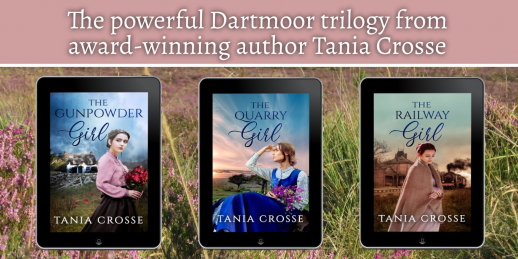A couple of weeks ago, I wrote a blog based around Tania Crosse's wonderful historical novel, The Gunpowder Girl. This week, I am delighted to welcome Tania herself to the blog to talk about three of her novels - The Gunpowder Girl, The Quarry Girl and the Railway Girl and the reserach and inspiration behind the three of them.
* * * *
THE GUNPOWDER GIRL, THE QUARRY GIRL & THE RAILWAY GIRL
The whole of my Devonshire series is inspired by the rich and fascinating history of west Dartmoor and the surrounding area. Drive across Dartmoor today, and most visitors will see the savage beauty of the rugged, spectacular landscape, and the adorable ponies, sheep and occasional cows grazing wild among the rocks and heather. Few, though, will realise that, as well as being grazed more intensely, in the past, Dartmoor was a place of dangerous and demanding industry. Each of the books in the series sets out to explore a different aspect of life on the moor, from leading a harsh existence and scraping a living from farming and mining, to other more unexpected employment.
The Gunpowder Girl is based on the history of the Cherrybrook Gunpowder Mills, sited at a remote spot in the middle of the moor and which existed throughout the second half of the Nineteenth Century but gradually went into decline with the invention of more sophisticated explosives. I simply let my imagination loose to envisage what it would have been like for a young woman to be living in such an isolated spot, but with strong loyalties to her family and friends. There is one other element in the story, however, that visitors to that part of the moor cannot fail to notice, and that is Her Majesty’s largest hotel – the infamous prison. In Victorian times, it was just as brutal, inhumane and barbaric as you might imagine. But it wasn’t just a hard life for the offenders. The prison officers and their families also led difficult lives in the exposed, windswept prison town of Princetown. Being only a few miles from Cherrybrook, it made sense to amalgamate the two into a tale of courage, determination and doomed love.
Dartmoor is littered with granite quarries, some so small only a few men worked them and you would scarcely notice them today. However, others were huge enterprises and supplied stone for famous landmarks in London. Haytor on the east side of the moor is well-known, but just as impressive – indeed to me, more so – is Foggintor on the west side. Approached along the granite sets of an original horse-drawn tramway, the quarry opens up into a massive amphitheatre where once a hardy race of men shinned up ladders and drove explosives into the natural cracks in the rocks to blast them apart. Most of these men lived in tiny, one-up, one-down cottages around a square, the ruins of which can clearly be seen today. On one corner can be seen the foundations of what was a small chapel that also served as a school – which is where my intelligent heroine, a quarryman’s daughter, works as the school assistant. Though engaged to her childhood quarryman sweetheart, The Quarry Girl yearns to learn about the world outside – and then in 1883, along comes the Princetown railway, opening up her horizons and connecting her to the outside world. On the day of the opening celebrations, she suffers an accident which brings a handsome young doctor into her life – an association that will tear her apart with conflicting emotions. Even the weather will play a part, notably the Great Flood of 1890 and the Great Blizzard of 1891.
For The Railway Girl, we move to the market town of Tavistock on the western side of the moor. The original GWR railway came to the town in 1859, but towards the end of the century, the London and South West Railway drove a different route through the town, and it was the building of this that inspired this novel. The mining boom was over and times were lean, especially for those working on the land. Soup kitchens were set up in the town, and the workhouse at the top of Bannawell Street was crowded. But when two thousand relatively well-paid navvies and their families appear on the scene, the local economy takes a step up. Itinerant farm labourer, Emmanuel, seeks employment on the railway, bringing his dairymaid daughter with him. She, though, is the driving force behind his lax ways. Their relationship with his Irish foreman on the railway is a challenging one, that will bring defiance, heartbreak and tragedy. Later, after its completion, the railway will play a part in the most horrendous trauma a woman can experience – the abduction of her child. If you already know the magnificent landscape of Dartmoor, you will understand how it has always provided me with such creative inspiration. But if you didn’t know about its history, I hope you will join with me in thinking about how it influenced the lives of those who lived on its wild uplands and surrounding towns in the past.
* * * *
Tania's Links: Tania's books on Amazon
Tania's Twitter page
Tania's page on Facebook
* * * *
|





Make A Comment
Comments (0)